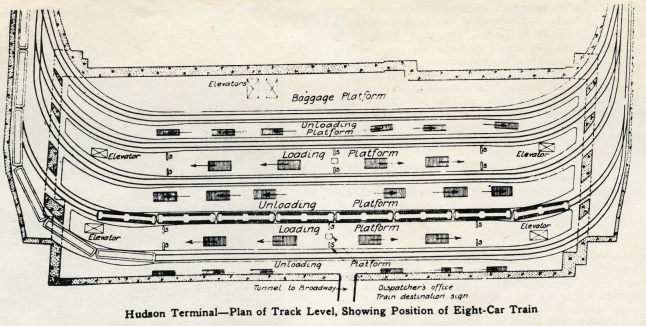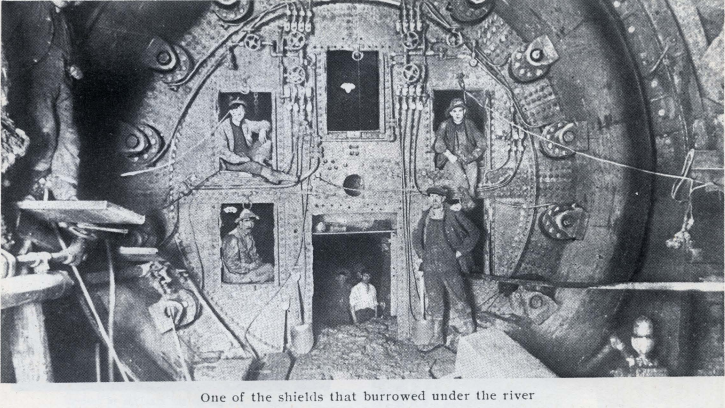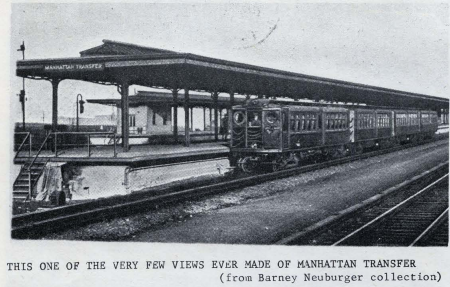West Portal: (Satellite)
While studying the PATH/Pennsy bridge over the Hackensack River, I learned that the Pennsy system was much more extensive in the New York Metro area than I had realized. Before Pennsy opened today's Northeast Corridor route in 1910, it had a 1958 route that terminated at a 5-track passenger station and ferry at what is now Exchange Place. The Hudson & Manhattan Railroad (H&M) opened the Uptown and Downtown Tunnels in 1908 to connect the railroad ferry stations on the west shore with stations they built on the Manhattan Island. [academic-tubes, academic-timeline]
 |
| Augie Ray Flickr via BridgeHunter, License: Creative Commons Attribution-NonCommercial (CC BY-NC) |
Since the Pennsy did not finish its North River Tunnel project until 1910, 1908 was the first time that passengers on the railroads "Central Railroad of New Jersey, Delaware, Lackawanna, & Western Railroad, Erie Railroad, Lehigh Valley Railroad, New York, Susquehanna, & Western Railroad, Pennsylvania Railroad, and West Shore Railroad" did not have to use a ferry to reach Manhattan. Construction began in 1874. It took a while (over three decades) to fight lawsuits, to figure out how to dig underwater through silt and to find enough sources of money to complete the job. [ASCEmetsection]
 |
| TransitMap "The Hudson Terminal Buildings (shown in the photo inset at top left) were replaced by the World Trade Center complex as part of the deal struck to allow the Port Authority of New York and New Jersey to take over the operations of the H&M RR." [Note the extensive streetcar network in Jersey City back in 1909. The extension in Manhattan made it north to 32nd Street. [academic-uptown]] |
 |
| EphemeralNewYork "Known as the Hudson Tubes, they were also called the McAdoo Tunnels, named after William Gibbs McAdoo [I kept getting 522 with this link, but I'm hoping it will get fixed.], who financed construction and led the efforts to link the two states by rail." |
The cars had doors on both sides so that passengers could exit to an unloading platform while others entered from a loading platform. One source called this platform arrangement the McAdoo System.
 |
| ppolinks, p8 @ 125% via hoboken |
 |
| TribeCatrib In 1909 the Hudson Terminal Buildings were then the world's largest office building complex and filled four city blocks on Church Street between Cortlandt and Fulton. The H&M was very successful until the advent of the automobile and the two vehicular tunnels under the Hudson River. The ridership peaked at 113 million passengers in 1927. It is worth noting that the Holland Tunnel opened in 1927. Ridership was down to 27m in 1958. It has rebounded to 82.8m in 2017. |
A connection of multiple-tube tunnels can be complicated.
 |
| Harry M. Pettit, Public domain, via Wikimedia Commons and academic-tubes |
Circa 1950s
 |
| New York Transit Museum |
The initial construction was done without a shield "because it was believed that the silt was strong enough to hold back the compressed air in the tunnel. A major blowout occurred on July 21, 1880 when a leak developed on top of the tunnel, letting out compressed air into the 30 feet (9.1 m) of silt between the tunnel and the river bottom. The hole grew larger and river water began to flood the tunnel, trapping 28 men inside. Eight men miraculously escaped through the air lock, but the remaining workers were trapped and killed." But in 1889 when they obtained financial backing by English investors, the investers insisted on the use of a shield. [ASCEmetsection] (Or it was another bad "blow-out" in 1890 that convinced the contractor that it should use a shield.) [ppolinks, p2 via hoboken])
 |
| ppolinks, p3 via hoboken |
 |
| ppolinks, p6 via hoboken The Pennsy worked with the H&M so that the H&M trains could operate on the Pennsy right-of-way to a station called the Manhattan Transfer that allowed passengers on the through trains to get off and take the H&M to downtown Manhattan rather than continue on their original train to the Penn Station in midtown. In 1937, H&M extended their service to the Pennsy station in Newark and closed the Manhattan Transfer station. |
 |
| NJ-lift-bridges, p29 via Dennis DeBruler |
No comments:
Post a Comment